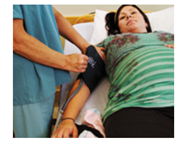
38-Year-Old Female with Preeclampsia
Ms. Johansen, 38, is 26 weeks pregnant with her first child. She was diagnosed with preeclampsia (see p. 1114) three weeks ago. Antihypertensive drugs (p. 724) and daily home care monitoring were initiated. However, her blood pressure is continuing to rise and is now 162/108 mm Hg. She complains of a constant headache, exhibits edema, and her urinalysis is positive for protein.

Her doctor has her admitted and orders further blood tests to assess Ms. Johansen's platelet level and liver function. "We may have to deliver because that’s the only cure for preeclampsia." she says to you during your clinical rotation in obstetrics. “But if we do, then the baby will have problems. It’s a tough decision because we have to balance both the mother's and the baby’s health.”
5. NCLEX-STYLE Cortisol prompts the fetal lungs to begin synthesizing surfactant. Why is this important?
a. Surfactant reduces surface tension in the alveoli, allowing the alveoli to inflate.
b. Surfactant causes vasodilation, allowing blood to flow through the lungs.
c. Surfactant is necessary to protect the cells lining the respiratory tract from drying out.
d. Surfactant attracts white blood cells into the lungs to protect them against pathogens.
Want to see the full answer?
Check out a sample textbook solution
Chapter 28 Solutions
Human Anatomy & Physiology Plus Mastering A&P with Pearson eText -- Access Card Package (11th Edition) (What's New in Anatomy & Physiology)
- M.H. is an 80-year-old Caucasian female who is married and lives with her spouse. She presents to your office today with her spouse, feeling “coocoo, I just don’t feel right.” Currently she is taking rosuvastatin prescribed by her cardiologist for hyperlipidemia and a daily 325 mg aspirin. She drinks 3–6 hard liquor drinks a day, 3–4 times a week in the evening, and has a 65-year smoking habit, currently smoking two packs per day (ppd). She has no known allergies. Past surgical history includes hysterectomy for a benign fibroid. Family history of breast cancer in three sisters, Type 2 diabetes and CVA in one sister, cancer of unknown origin in one brother. All siblings and parents are deceased. Her husband reports that she is hard of hearing. He feels that it is due to cerumen build-up in her ears. She refuses to have the buildup removed. Her husband is also worried about her memory—states that she “just does not remember things like she used to. She keeps asking me the same questions…arrow_forwardJohn Doe, 53y.o., has a history of Type I diabetes mellitus, cigarette smoking 40 pack-years, CAD, and PVD. Six weeks ago, he developed a wound in his left heel which measured 4cm by 2cm when he discovered it. Despite IV antibiotics and chemical debridement, the wound developed a gangrene infection. He is scheduled for a BKA of the left lower extremity tomorrow at 10:00 am. His meds include daily insulin, aspirin 325mg/day, Pletaal 100mg BID. Question: Preventing complications of surgery is an important part of all surgical patient care. What preoperative While Mr. Doe is in the Operating Room, what considerations will be taken to ensure Mr. Doe’s safety and positive outcome? Identify 2 IntraOp nursing diagnoses for Mr. Doe teaching does Mr. Doe require in order to prevent complications? Give 3-4 examples)arrow_forwardDescription A-45-year-old woman presents complaining of fatigue, 30 pounds of weight gain despite dieting, constipation, and menorrhagia. On physical examination, the thyroid is not palpable: the skin is cool, dry, and rough: the heart sounds are quiet; and the pulse rate is 50 bpm. The rectal and pelvic examinations show no abnormalities, and the stool is negative for occult blood. The clinical findings suggest hypothyroidism. Questions A. What other features of the history should be elicited? What other findings should be sought on physical examination? B. What is the pathogenesis of this patient's symptoms? C. What laboratory tests should be ordered, and what results should be anticipated? D. What are the possible causes of this patient's condition? Which is most likely? E. What other conditions may be associated with this disorder?arrow_forward
- A 62-year old, recently widowed male Hispanic patient, KB. was brought in to the emergency department (ED) by his daughter for progressively worsening shortness of breath, fatigue, a lingering non-productive cough, and generalized edema. One month prior, he noticed dyspnea upon exertion, loss of appetite, nausea, vomiting and malaise, which he attributed to the flu. In the emergency department, he appeared anxious and pale, and had a dry yellow tint to the skin. He denied any chest pain, and he could not recall the last time he urinated. He has history of benign prostatic hyperplasia, diabetes mellitus type 2, hypertension, dyslipidemia, and renal insufficiency for the past two years. His ED assessment findings included: 1+ pedal edema, basilar crackles in the lungs bilaterally, and a scant amount of urine according to a bladder scan. His lab results indicated a glomerular filtration rate (GFR) of 12. Based on his subjective and objective symptoms, he was admitted with a diagnosis of…arrow_forwardA 10-year-old boy with known HbSS disease presented to the Paediatric Emergency Department with a oneweek history of fever and severe pain in his right leg, severity 9/10 for the last two days. On examination:Pulse – 100 beats/min, BP – 110/70 mmHg, Capillary refill < 2sec and Respiratory rate – 20 breaths/ min. He has point tenderness anteriorly on proximal tibia. There is no joint swelling.X-ray of the affected limb shows marked periosteal elevation.His complete blood count is: Hb – 6.5 g/dL WBC 30 x 10 /L Plt – 120 x 10 /L with a reticulocyte count of 1%.Of the following the MOST appropriate management in this patient would bea. Ibuprofen, Cefotaxime and top-up transfusionb. Morphine, Ampicillin and hydration therapyc. Morphine, Cefotaxime and hydration therapyd. Morphine, Cefotaxime and top-up transfusionarrow_forwardA 79-year-old woman presents at the Emergency Department with generalized complaints: constantly feeling tired and unwell. Her heart rate was in the range of 110 – 120 beats per minute and her blood pressure was 150/100. She complaints of dry cough and gasping of air. She also states that over the last 2 weeks she has noted that her breathing difficulty has severely limited her activities and has increased to persist even at rest, especially when lying down. She also reports of sudden awakening at night. On enquiry, she reports a recent weight gain along with a general reduction in her state of health. She explains that she has diabetes Type 2 (diet-controlled) from the last 5 years and hypertension since she was 40 years old. Her father died at age 85 due to ‘old age’, her mother died at age 88 after a hip fracture, and a brother age 80 alive with no significant history. She is on Minoxidil 10mg po bid for her hypertension, and has no known drug allergies. She denies any chest pain,…arrow_forward
- 10:28 ull NCM 112 RLE Case Report A 32-year-old man was referred to the emergencies of our hospital because of a right lower limb critical limb ischemia. Past medical history included chronic alcoholism and a three- month history of bilateral intermittent claudication. He did not report any episode of superficial thrombophlebitis. He smoked about 10 cigarettes since the age of ten and 10 cannabis joints daily since the age of twelve. He had no other cardiovascular risk factors. At clinical examination, his right leg was extremely painful and pale. He had absent pedal pulses on both sides, and a mild sensory loss on the right side. Allen's test of upper extremities was negative. Echo Doppler was suggestive of a bilateral common iliac occlusion and of a three-vessel occlusion on the right leg. A computerized tomography (CT) angiography detected the presence of an intraluminal aortic and iliac clot and a bilateral ibial essels occlusion. The patient was fully anticoagulated with…arrow_forwardWhat complications is Mr. E at risk for following general anesthesia and a below-the-knee amputation (BKA)? Please explain Note: -Mr. E is a smoker, has heart disease and diabetes type 1 as well as PVD -This is during the postoperative Phasearrow_forwardAn 86-year-old woman with a history of diabetes and hypertension presents to the emergency room with a complaint of chest pain x 4 hours. And I noticed intense nausea with two bouts of vomiting, too. She is now free of chest pain. Her blood pressure is 130/70, heart rate 50, breathing 20, and oxygen saturation 95% in room air. A physical examination reveals normal breathing sounds. 1- What is the medical diagnosis? 2- What is the specific investigation in order of priority? 3 What is the link between a patient's history and diagnosis? 4- Nursing care for this patient.arrow_forward
- What would be the laxative of choice for a 1-year-old child? Why is this the best choice? What nursing considerations are necessary when using laxatives in children?arrow_forwardPatient R., 32 y/o, was delivered with complaints of fatigue, decrease of appetite, intensification of pigmentation in the open areas of the body, palms of the hands, cyanosis, losing weight, nausea and vomiting. The symptoms began to aggravate during 1-2 weeks after acute poisoning. Objectively: arterial pressure – 60/30 mm column of mercury, pulse – 140 beats/minute, skin turgor is lowered, the colour is dark with intense pigmentation of the elbows, scars, skin folds on the palms; clearly low levels of sodium and chlorine, high levels of potassium in the blood; glycemia – 4.3 mmol/l. What is your diagnosis?A. Addisonian crisisB. Uremic coma C. Brain comaD. Acute cardio-vascular insufficiencyE. Hypoglycemic comaarrow_forwardName: George Davis; Gender: Male; Age: 65; Marital Status: Married Weight: 271 lbs (122.93 kg); Height: 70 inches; Race: Caucasian; Religion: : Agnostic Allergies: None known; Immunizations Up to date Occupation: Retired; Address: New York, USA Provider: Dr. Potter, MD, and RN and Nursing Assistant Major Support: Delilah Davis, Wife. Phone number: 605-475-6961 History George presents to the ER with recurrent headaches, fatigue, and a blood pressure of 185/102. The patient is a long-time smoker, leads a relatively sedentary lifestyle, and has a BMI of 39. He has a history of acid reflux. The plan is to keep George overnight for observation and to administer medications to help control his blood pressure. Medications *Hydrochlorothiazide 25 mg oral Daily 0900 5 mg oral Daily 2000 Dosage Route Frequency Hours/Date of Administration Pantoprazole 20 mg oral Daily 0900 *Simvastatin 40 mg oral Daily 0900 Notes: Patient’s blood pressure taken just before transferring to the Med/Surg floor:…arrow_forward
 Microbiology for Surgical Technologists (MindTap ...BiologyISBN:9781111306663Author:Margaret Rodriguez, Paul PricePublisher:Cengage LearningBasic Clinical Lab Competencies for Respiratory C...NursingISBN:9781285244662Author:WhitePublisher:CengageUnderstanding Health Insurance: A Guide to Billin...Health & NutritionISBN:9781337679480Author:GREENPublisher:Cengage
Microbiology for Surgical Technologists (MindTap ...BiologyISBN:9781111306663Author:Margaret Rodriguez, Paul PricePublisher:Cengage LearningBasic Clinical Lab Competencies for Respiratory C...NursingISBN:9781285244662Author:WhitePublisher:CengageUnderstanding Health Insurance: A Guide to Billin...Health & NutritionISBN:9781337679480Author:GREENPublisher:Cengage





